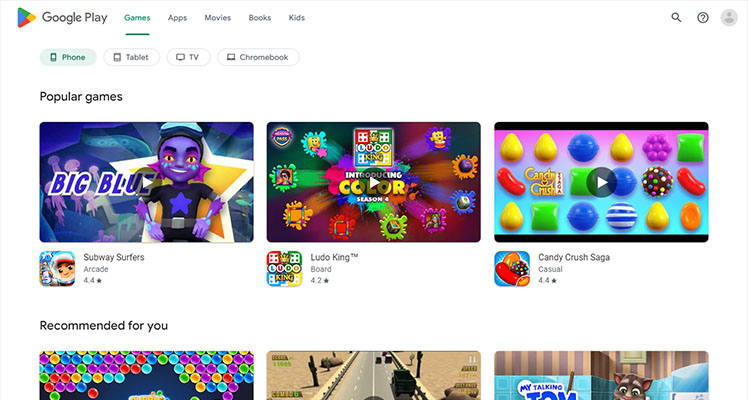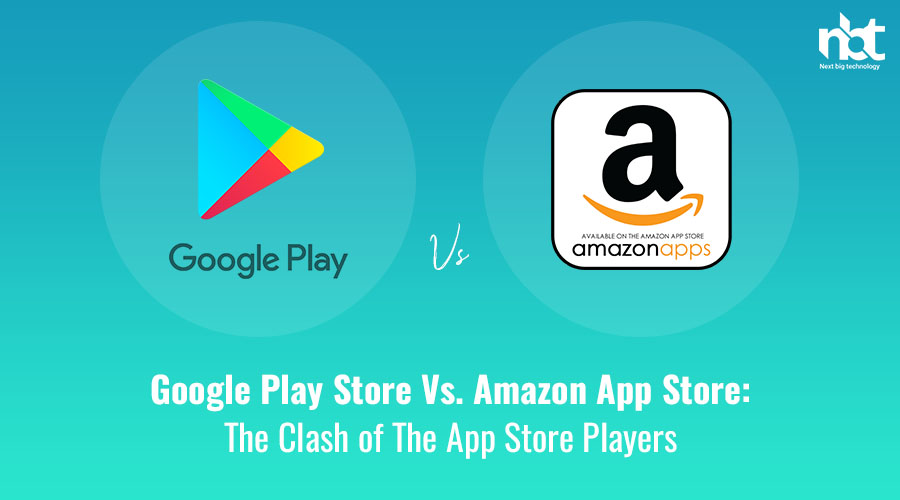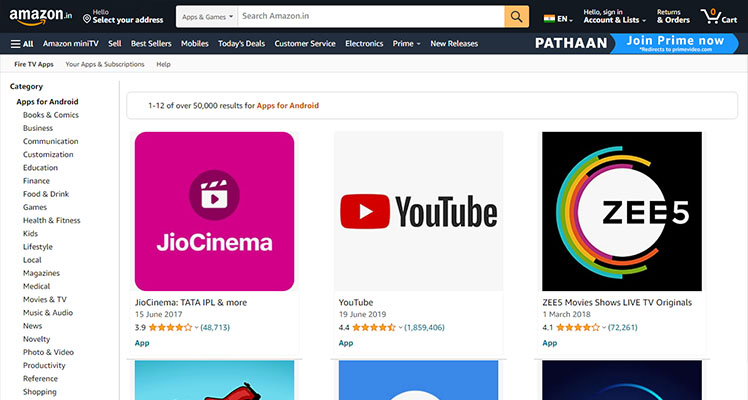Table of Contents
INTRODUCTION
The app store landscape is highly competitive, with two major play stores in the market namely Google Play Store and Amazon App Store. Both offer a wide variety of apps for Android devices that can be downloaded on the device, and each has its unique features and advantages. Google Play Store is the default app store for Android devices and offers the largest selection of apps, while Amazon App Store is designed to work with Amazon’s ecosystem of products and services. The two stores have been in competition for years, with each striving to attract more users and developers to its platform. In this clash of the app store players, we’ll explore the key differences and similarities between the Google Play Store and Amazon App Store, and how they compare in terms of app selection, pricing, user experience, and more.
However, when compared to Google Play Store, Apple App Store download has a long way to go. As data compiled by the Statista suggests, Android users can choose between 3.8 million apps, followed by Apple’s App Store, which remained the second-largest App Store with 2 million available apps. On the other hand, the Amazon App Store stands at the fourth position with a little less than half a million apps.
GOOGLE PLAY STORE

Features and Navigation: The Google Play Store interface is simple and easy to navigate with a search bar at the top that allows users to search for specific apps. Its primary function is to make installs and managing apps conveniently. There are various categories of apps available on the platform such as games, productivity, social, and more. Additionally, the platform offers personalized app recommendations based on a user’s previous downloads and search history.
Pricing: Google Play Store offers both free and paid apps with a range of pricing options, including one-time purchases, subscriptions, and in-app purchases. The platform has a diverse pricing structure with many apps available at reasonable prices. In addition to the standard pricing, the platform also offers promotional deals and discounts on apps.
Security: Google Play Store has rigid security measures in place to protect users from harmful apps. The platform uses Google Play Protect, which continuously scans apps for malicious software and other security issues. Additionally, Google also has a bug bounty program, which incentivizes researchers to find and report security susceptibility in apps.
Developer Support: Google Play Store offers a variety of tools and resources for developers to publish their apps on the platform. This includes the Google Play Console, which is a suite of tools for managing apps on the platform, including app listing, pricing, analytics, and more. Additionally, Google provides developers with guidelines and best practices for app development and submission.
Updates: Google Play Store provides regular updates for its apps, ensuring that they are always up-to-date with the latest features and security patches. The platform also offers automatic app updates, which can be enabled in the settings menu, to ensure that users always have the latest version of an app.
Pros:
- Huge Selection of Apps: Google Play Store has over 2.8 million apps available for download, which makes it the largest app store for Android devices. With such a wide selection of apps, users can find virtually any type of app they need, from productivity tools to games and entertainment apps.
- User-Friendly Interface: Google Play Store has a simple and intuitive interface that is easy to use, even for those who are not tech-savvy. The interface is designed to help users find and download apps quickly and easily, with a search bar and various categories of apps available.
- Diverse Pricing Structure: Google Play Store offers a range of pricing options, including free and paid apps, one-time purchases, subscriptions, and in-app purchases. This diverse pricing structure enable users to find apps that fit their budget.
- Regular Updates: Google Play Store provides regular updates for its apps, ensuring that they are always up-to-date with the latest features and security patches. This helps to improve the overall user experience and ensures that apps are safe and secure to use.
- Google Play Protect: Google Play Store has robust security measures in place to protect users from harmful apps. Google Play Protect continuously scans apps for malware and other security issues, which helps to keep users safe from cyber threats.
- Uncomplicated app publication: It allows developers to easily submit their apps for review with Google providing automated checks and providing suggestion for necessary changes.
Cons:
- Malware and Security Risks: Despite the security measures, Google Play Store is not immune to malware and security risks. Malicious apps can still make their way onto the platform which can potentially compromise user data and privacy.
- App Quality: While Google Play Store has a wide selection of apps, not all of them are of high quality. Some apps may be poorly designed or have bugs that can affect their performance. Users may have to rely on reviews and ratings to determine the quality of an app before downloading it.
- Fragmentation: The Android ecosystem is fragmented, with many different versions of the operating system in use. This can sometimes lead to compatibility issues between apps and devices which can affect the user experience.
- Fierce competition: Google Play Store faces fierce competition in app market due to the number of apps available on the store. Developers need to create high quality apps that provide uniqueness to stand out from the competition.
- Region Restrictions: Some apps on Google Play Store may be restricted to certain regions or countries, which can limit the users in other areas.
- Review Process: While Google Play Store has a review process in place for apps, some users may feel that the process is not rigorous enough. This can lead to apps with poor quality or security issues being approved and made available for download.
AMAZON APP STORE
The Amazon Appstore is a digital distribution platform for mobile devices. It offers a curated selection of apps, games, and digital content for Android-based devices, as well as Amazon’s own Fire tablets and Fire TV devices. The Appstore features a daily deal called the “Free App of the Day” and a virtual currency called Amazon Coins that can be used to purchase apps and other digital content. Additionally, the Appstore offers robust parental controls, cross-platform compatibility, developer tools, and appstore optimization strategies. These features make the Amazon Appstore a popular choice for users who want a more curated selection of apps and a way to save money on premium apps, as well as offers developers another opportunity to reach a wider audience.
Pros:
- Curated Selection: The Amazon Appstore offers a curated selection of apps that have been reviewed and approved by Amazon. This can help users find high-quality apps more easily than on other app stores.
- Free App of the Day: The Appstore offers a daily deal called the “Free App of the Day,” which allows users to download a premium app for free. This can be a great way to discover new apps and save money on premium apps.
- Better discount schemes: Amazon Appstore offers various discount schemes to attract customers, increase app downloads, apps visibility and generate more revenue .
- Parental Controls: The Amazon Appstore offers robust parental controls that allow parents to restrict access to certain apps and content. This can help parents control their kids while using mobile devices.
- Cross-Platform Compatibility: The Amazon Appstore is compatible with a range of devices, including Amazon’s own Fire tablets and Fire TV devices, as well as Android-based smartphones and tablets.
- Uncomplicated ASO: Amazon Appstore optimization (ASO) is a set of strategies used by developers to improve the visibility and ranking of their apps on the Appstore. This can help developers increase the number of downloads and revenue from their apps.
Cons:
- Limited App Selection: In comparison to the Google Play Store, the Amazon app store has a smaller selection of apps available for download. This can limit users who want to find a specific app that is not available on the Amazon app store.
- Limited Availability: The Amazon app store is not available in all countries, which can be frustrating for users who live in regions where it is not available.
- Incompatible with Google Services: The Amazon app store is not compatible with Google Play Services which means that some apps that rely on Google services may not work properly or may not be available for download.
- Delayed App Updates: App updates on the Amazon app store are often delayed compared to the Google Play Store, which means that users may not have access to the latest features and bug fixes for some apps.
- Tablet specific: Amazon Appstore has various tablet specific features that are designed to optimize user experience on larger screen devices.
CONCLUSION
The clash of the app store players, namely Google Play Store and Amazon App Store, has created a highly competitive market for app developers and users. Each app store has its own strengths and weaknesses, and the choice of app store depends on the user’s preferences, device, and location.
The Google Play Store and Apple App Store have the largest app selection and user base, making them the go-to choices for developers and users. Both app stores also have robust discovery features, strong security measures, and easy-to-use interfaces. However, the App Store is exclusive to Apple devices, while the Google Play Store is available on Android devices.
The Amazon App Store, on the other hand, offers a more limited app selection, but is a viable alternative for Android users who are not able to access the Google Play Store, or who prefer Amazon’s ecosystem. The Amazon App Store also has its own unique features, such as a free app of the day promotion and integration with Amazon’s Prime services.
Overall, the clash of the app store players has led to a healthy competition that benefits developers and users alike, driving innovation and improvements in the app store experience.
Thanks for reading our post “Google Play Store Vs Amazon App Store”. Please connect with us if you need more information about App stores.











